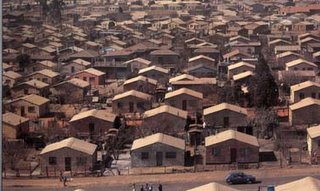
A visit to Soweto is an emotional roller coaster, however, being the most famous of the “townships” created by the Apartheid government to segregate its population, Soweto is a must see for anyone trying to understand this chapter of South Africa’s history. Its grid of indistinguishable drab box homes are a testament to what happens when a government has no concern for the welfare of a segment of its people. It is also here that the movement that would eventually dismantle that system first took root, and its people talk with pride about the part they played in its undoing.
I spoke with locals in a shebeen (township bar). One guy told me about how he and other youth organizers had to pretend that they were a swimming club and meet in secrecy at the pool. It was illegal for blacks to assemble in large groups under apartheid. He laughed about how it was sometimes difficult to take one another seriously while standing in their bathing suits. “Not one of us could swim” he said with another great laugh. Another middle-aged man told me emphatically, "none of this was here", gesturing to the things in front of us, "the roads, the cars, that gas station, that market, none of it was here - it was only dirt." The others at our table nodded, and I could see them envisioning the Soweto of their youth. This was perhaps the most tangible impression I had yet of what had changed since the end of Apartheid in South Africa. Indeed the signs of improvement were everywhere in Soweto. There were still “unofficial settlements” within Soweto – shanty towns of currigated iron and make shift fences that illustrated a poverty that could not be denied. But the signs of development were everywhere - electric lines and sewer systems being laid out. There was a huge hospital, the largest in the southern hemisphere. People owned cars. It was clear that with the restrictions of apartheid lifted the material things were trickling in.

An old coal burning plant that had been beautified

Me and "grandma"- she said she was 86 and had never had her picture taken.
1 comment:
Winston,
I can't believe you are interacting with people who have never had their pictures taken. You hear of those things in the news and see them in documentaries, but it becomes quite apparent the magnitude of your undertaking when you see the type of people and the parts of the world you are seeing right now.
We miss you a lot and are wish we were there with you.
Post a Comment